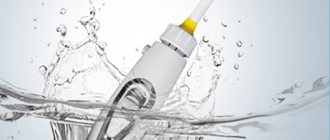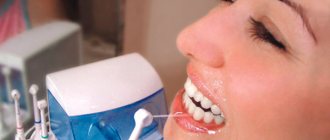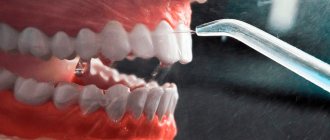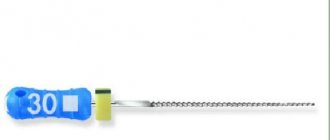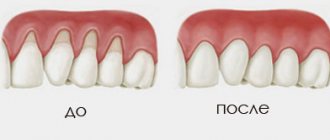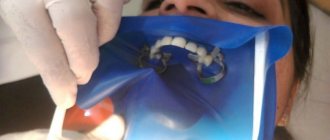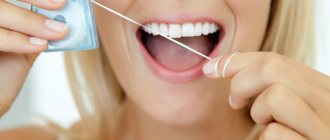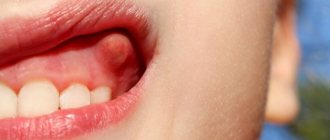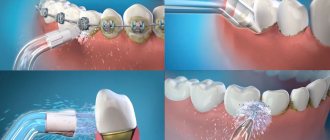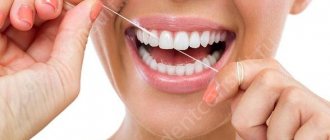Good oral hygiene is extremely important not only to maintain an aesthetically attractive appearance, but also to maintain the healthy functioning of the body as a whole. Currently, there are many functionally useful devices for hygienic treatment of the oral cavity. One such device is an irrigator.
In this article we will try to tell you in detail about how to properly use an irrigator to clean your teeth and how often you can use an oral irrigator .
Why do you need an irrigator and how does it work?
An irrigator is essentially a device that treats the oral cavity using a focused jet of water supplied under high pressure. The enhancing effect is the pulsating mode of liquid supply. As a result of this treatment, full-scale removal of contaminants occurs both from the surface of the teeth and gums, and from the interdental spaces.
In connection with the popularization of irrigators, consumers have a number of questions, the most pressing of which are: how to properly use an irrigator for cleaning teeth and how often can you use a dental irrigator ?
At what age can children use an irrigator? In order to answer these and many other questions related to the use of this relatively new device for us, it is necessary to consider in more detail some of the nuances.
How much does an oral irrigator cost?
The cost of an irrigator for cleaning gums and enamel depends on the mass of parameters and starts from 4 thousand rubles. Portable devices with a monojet are considered the most affordable; devices using microbubble technology are the most expensive.
If we consider the most popular models, we can understand the approximate prices:
- Donfeel OR-820M – from 4.4 thousand rubles.
- Waterpik WP-100 – from 6 thousand rubles.
- Oral-b OxyJet – from 11 thousand rubles.
Despite the fact that the prices are steep, this device is worth choosing for anyone who cares about their smile. In the future, much more money will be saved on dental services, and spending on a teeth cleaning device will pay off.
Indications for use of the irrigator
- Prevention of caries. Due to the fact that the effect of the irrigator extends to the most inaccessible areas of the oral cavity, it becomes a good prevention of many dental diseases, the main and most common of which is caries. The irrigator is able to clean both the surface of the front teeth and wisdom teeth, which are the most inaccessible, and therefore are recognized as the most vulnerable dental units;
- Prevention of gum disease. A focused and dense stream supplied by the irrigator has a massaging effect on the surface of the gums, which in turn serves as a good prevention of many diseases, including bleeding;
- Care of implantation, prosthetics and braces systems. The irrigator is capable of efficiently and quickly processing both the surface of prosthetic elements and the cavities hidden behind them;
- Prevention of gingivitis. A massaging jet of water stimulates and restores impaired blood supply to soft tissues. This procedure is most relevant for pregnant women who have the greatest tendency to develop this disease;
- Prevention of unpleasant odor. The irrigator efficiently washes away food debris, which is a source of unpleasant odor, even from the most inaccessible areas of the oral cavity;
- A history of nasopharyngeal diseases. This direction is an additional option and requires special nozzles suitable for rinsing the nasal passages. Such treatment is carried out only on the recommendation of an otolaryngologist.
Doctor's advice - it will take a lot of time to prepare for implantation
The patient should be prepared for the fact that treatment and preparation for implantation will take a long time - on average 1 year. These are necessary measures, since regardless of the causes of the disease, when installing implants, the doctor is faced with resorption of the jaw bone and unsatisfactory condition of the gums. Osteoplasty in conditions of inflammation is also not performed. First, the source of infection is stopped, and then bone tissue is augmented.
Levin Dmitry Valerievich
Chief physician, Ph.D.
Contraindications to using an irrigator
There are literally no such contraindications. There are some restrictions on the use of this device.
Limitations of using the irrigator:
- Children under six years of age;
- Excessively developed gag reflex;
- Diseases of the oral cavity during exacerbation;
- Postoperative conditions;
- A history of serious neurological and cardiovascular diseases;
- increased sensitivity of teeth and bleeding gums.
Types of irrigators
- Stationary. The jet power of such an irrigator should not be less than 550 kPa. The stationary mounting device has a softer and more comfortable system for switching modes, which is an undeniable advantage if the users include children, the elderly and people with disabilities. The optimal level of jet pulsation corresponds to 1200 pulsations. The device is mounted on a horizontal surface. A relative disadvantage of the installation can be considered its rather large dimensions. In this regard, stationary irrigators are installed in the bathroom. Power is supplied from the electrical network. A distinctive feature is the large volume of the liquid reservoir, a powerful motor and the creation of high pressure when supplying liquid.
- Portable irrigators. The advantage of such irrigators is their complete autonomy due to the ability to operate on a battery, which allows you to take the device with you on trips. The power ratings of a portable device should not be less than 520 kPa. Changing operating modes occurs in a stepwise manner.
- Flow irrigators. The simplest device installed directly on the water tap. The force of the jet is regulated by the mixer valves.
- Mechanical irrigators. Water pressure is created by pumping by pressing the built-in piston.
In addition to the installation method, irrigators differ in the type of jet supplied.
Requirements for implants
The selection of titanium rods is carried out at the preparatory stage, taking into account a number of requirements:
- high primary stability;
- a special surface that improves fusion with jaw tissue and is resistant to the accumulation of microbes.
In the world, only three manufacturers produce implants for installation in periodontitis and periodontal disease, the leader of which is Nobel Biocare (Switzerland). It is these systems that our clinic works with, which allows us to guarantee a successful result.
Implantation is carried out after stopping foci of infection, complex treatment and rehabilitation, with rods with the following properties:
- the tight fit of the abutment to the gum protects the underlying bone and guarantees long-term stability and health of the gingival structures;
- Smooth anodized coating created using nanoparticles improves soft tissue attachment;
- the single orthopedic platform On1 allows you to preserve the structure of connective tissues and avoid surgery during further prosthetics.
Types of irrigators by type of jet supplied
- Monojet. They represent a continuously supplied flow having the same power and direction;
- Turbo flow with pulsation. The most modern technology, characterized by the supply of micro-hydro-impact jets that target specific areas.
The optimal level of jet frequency is considered to be 1200 pulsations per minute. Some models allow you to reproduce frequencies in excess of 1700 beats.
The classic volume of the reservoir, designed for one session (one cleaning) is 150-200 ml of water for portable and 500 ml more for stationary irrigators. The correct selection of the cleaning attachment plays an important role.
Key factors when choosing an irrigator
If you want to improve blood circulation in the gums, reduce the risk of inflammation and increase the service life of dental implants, using irrigators on an ongoing basis is simply necessary. Above we have presented the best model range, but if none of the options suits you for some reason, check out the parameters that will help you choose the ideal solution yourself:
- Water pressure
. The most important aspect that directly affects the quality of oral cleaning. The stronger the pressure, the more effective the irrigator, it's simple.
- Tank volume
. Consider this parameter to purchase a device that can perform its task for a long time and productively, and not require refueling every 30 seconds.
- Type of jet
. Water is supplied in different ways, most often it is a pulsating and micro-bubble type of pressure.
- Pulse frequency
. Having given preference to a pulsating jet, you need to figure out what frequency of blows is presented on the device. It would be desirable to have a separate intensity control function.
- Equipment
. A rich set is always nice, but keep in mind that much of what comes in the package can be purchased independently if the need arises.
- Type of design
. You remember that we talked about both portable and stationary irrigators. Determine your tasks and buy the right solution.
- Types of nozzles
. If you wear braces or have very sensitive gums, find out in advance whether a certain type of attachment will suit your needs or not.
The irrigator can be used for both preventive and therapeutic purposes. Doctors recommend the use of such devices for gingivitis, gum disease, periodontitis, various malocclusions and periodontal disease. In short, an irrigator is a universal solution for cleaning teeth. Choose a device based on our recommendations, then the irrigator will only delight you with taking care of your oral health.
Which nozzle to choose for using an irrigator
There are several different attachments for the irrigator, the choice of each of which depends on the required purposes:
- Standard. Designed for treating teeth and gums without signs of disease.
- Orthodontic. It will be the best option for people using any type of prosthetic systems. This attachment allows you to remove plaque and dirt under bracket systems and bridge retainers with the highest quality possible.
- Periodontal attachment. It is considered a highly targeted accessory. It is used only at minimum power levels and is necessary for cleaning interdental spaces.
- Implantation attachment. As the name suggests, it is used in cases when it comes to the need for hygiene of teeth with implants and crowns. A distinctive feature is the presence of 3 tufts of bristles on the tip.
- Tongue treatment attachment.
- Brush type nozzle. It should be noted that such an attachment cannot act as an absolute substitute for a toothbrush.
We should also highlight the additional function of the irrigator. The essence of this direction is preventive measures in the treatment of sinusitis and rhinitis. In this case, a specialized nozzle and an individually selected mode are used.
Making your own irrigator from a syringe
An irrigator can be made from a syringe. To do this you will need the following tools:
- 5 ml or 20 ml syringe (volume depends on personal needs);
- sandpaper for grinding down the needle point;
- mouth rinse.
Tools for making a DIY irrigator
The device is quite easy to make yourself. To do this you will need to do the following:
- Take the needle from the syringe and carefully grind off the tip with sandpaper. You can use sharper tools, such as a knife, to remove the pointed part. Next, you need to sharpen the damaged surface so that when using a homemade device, family members do not damage the gums.
- Carefully bend the remaining part of the needle so that it resembles a standard nozzle in shape.
- If the needle cannot be bent, you can heat it a little over the fire and carefully bend it into the required shape.
- To use a home-made device, you need to assemble the syringe, remove the plunger and pour in the used teeth cleaning product.
- Then insert the piston into the syringe and, using gentle pressure, provide the necessary pressure for the jet. In this way, the interdental spaces are cleaned from food debris, protecting teeth from plaque.
Option for a homemade irrigator from a syringe
Some masters use a speed regulator from a simple medical dropper instead of a needle. To do this, cut off the required length of the nozzle and secure it with wire. The regulator can be used to adjust the fluid supply power. The homemade device is not recommended for use for cleaning the mouth of children.
Syringe with dropper regulators
What liquid to pour into the irrigator
To refill the device, liquids are used, which, depending on the composition, have one or another effect.
Main types of compositions:
- Fluoridating. Aimed at strengthening tooth enamel;
- Therapeutic and prophylactic. Contain antiseptic additives, mostly of plant origin;
- Refreshing. The composition of such liquids includes menthol and eucalyptus, which help freshen breath;
- Antiperiodontal. Contains various biooxidants and anti-caries components;
- Hypoallergenic. They have a neutral composition, suitable for people prone to allergic reactions.
The most popular balms for irrigator
“Terasol” (antimicrobial effect), “Denfil” (alcohol-free balm, acceptable for use in children), “Asepta” (caries prevention), “Irix” (non-foaming balm with menthol to freshen breath).
The use of tap water is extremely undesirable due to the risk of device failure, since this water contains sedimentary components.
If it is impossible to use balsamic liquids, you can use boiled or special purified water.
Which dental irrigator to choose
Basically, irrigators are divided into 2 types: stationary and mobile. Stationary irrigators have a large capacity for liquid (about 1000 ml), operate from the mains and their main distinguishing feature is high power. Mobile (portable) irrigators are light in weight, the volume of liquid is almost 2 times less than that of stationary ones (400-500 ml) and operate on batteries.
If you plan to mainly use the irrigator at home, then it is certainly better to buy a stationary irrigator, since you do not need to buy batteries for it, and the large volume of the liquid reservoir is enough for several uses, or for use by two people.
If you travel often, it is better to take a portable irrigator model, since it takes up little space and does not require an outlet to operate.
Criterias of choice
Kinds. Depending on the design, there are two types of irrigators:
- Stationary. The devices operate from the mains and are used at home. They have many attachments and different operating modes, so they are suitable for the whole family.
- Portable. These irrigators are battery-powered and small in size, making them suitable for travel. However, their power is not as high as that of stationary models and they perform fewer functions.
Based on the type of pulsating jet in the device, three types of irrigators are distinguished:
- With a pulsating jet. The device creates a thin stream with short pulsations that create microhydraulic shocks. This type of device is recommended for people at risk of developing periodontitis or gingivitis.
- With microbubble technology. This type of device is considered the most effective, since the irrigator mixes air bubbles with a stream of water. This technology allows you to better remove plaque and food debris, as well as wash the nose and oropharynx for various diseases.
- With monostring. The device supplies a continuous stream of water; it does not require an electrical connection. However, without a special filter, it is impossible to use such a device by connecting it to a tap due to the poor quality of the water.
Cleaning technology. The first important point is the presence of pulsations of the water jet. These pulsations are so short (in different models of irrigators this figure ranges from 1200 to 2000 micropulses per minute) that they are unnoticeable. Pulsations create micro-hydraulic shocks, which make it possible to more effectively remove food debris and soft microbial plaque (compared to a water jet without pulsations). There is no particular difference between the models of irrigators that perform 1200, 1400 or 1800 jet pulsations. Those. in this case, “more” does not mean “better.” The second important point is the pressure of the water jet (measured in kPa), i.e. her pressure. The optimal indicator is 500-550 kPa, but there are also more powerful models of irrigators that produce water jet pressure even up to 870 kPa. This can hardly be called a competitive advantage, because... using such pressure is already quite painful for the gums. And patients, even with healthy gums, are unlikely to be comfortable using an irrigator with such a strong jet pressure. The third important point is the ability to regulate the pressure of the water jet. Moreover, it is necessary to have a smooth adjustment, i.e. selection from at least 4-5 preset levels. Reviews of dental irrigators very much depend, among other things, on the availability of smooth adjustments to the water pressure. It is optimal that the minimum level corresponds to a pressure of about 70 kPa, because You will have to start using the irrigator with a small pressure, gradually (from time to time) increasing it. The fact is that the standard water jet pressure of 500 kPa will be quite painful if you are just starting to use the irrigator. At the same time, lower water pressure will also allow the irrigator to be used not only by adults, but also by children, as well as people with sore gums. But strong pressure can, on the contrary, only increase bleeding of the gums. In addition, the presence of levels with low pressure of the water jet (and with a special nasal nozzle) will allow the irrigator to be used for rinsing the nasal passages with a weak saline solution, for example, in patients with rhinitis or sinusitis. The fourth important point is the presence of microbubble technology. This is an advanced technology developed by , but lesser-known companies have now begun to use it. This technology allows mixing of water flow and air bubbles, i.e. air aeration occurs (air content in water reaches 5%). As a result, the water stream will contain a large number of microbubbles, which will allow us to achieve two important things. Firstly, when microbubbles explode, they also create microhydraulic shocks, which contribute to even more effective removal of food debris and plaque. And secondly, air microbubbles saturate the water with oxygen, which has a bactericidal effect on pathogenic microflora. This is especially important for patients with gum disease, such as gingivitis or periodontitis. The fifth feature is the presence of different modes. Most irrigators have only 1 operating mode in the form of a pulsating monojet, but some models have additional modes. When you select the “turbo flow” mode, the built-in mini-turbine in the nozzle is activated, which begins to spin at a speed of 8000 rpm. As a result, a spiral-shaped jet stream is formed, which is optimal for gum massage.
Types of attachments for irrigators. Some irrigators have universal nozzles, others have whole sets of nozzles for all kinds of cases. In addition to universal ones, there are attachments for cleaning the tongue, for washing periodontal pockets, attachments for cleaning orthodontic structures (braces), attachments for cleaning artificial crowns and bridges, and attachments for cleaning implants. Also, some models have special nasal nozzles that allow you to rinse the nasal cavity with an irrigator, which is sometimes necessary in the treatment of rhinitis (including allergic origin) and sinusitis. Most manufacturers produce attachments that have different color indicators. This is very convenient, because... Each family member will have a nozzle of its own color, and will never confuse it with other people's nozzles.
Capacity. Stationary models hold an average of 400-1000 ml of water, and portable ones - from 150 to 300 ml. If you are going to use the device while traveling, you can buy a compact type irrigator for implants and sacrifice the volume of the tank. For home and family use, it is better to opt for a more spacious model.
How often can and should you use an irrigator?
In order to understand how many times a day you can use the irrigator, you need to determine the ultimate purpose of using the device. So, for normal oral hygiene, you can use the irrigator once a day, or every other day. The use of specialized balms for prophylactic purposes is allowed no more than 2-3 times a week.
Excessively frequent use of an irrigator can lead to the opposite consequences, namely, thinning of the enamel layer and expansion of gum pockets in areas of periodontitis.
Implantation options depending on the severity of the disease
| Partial implantation (remaining teeth are retained ) | Full implantation (all teeth are removed) | |
| Depth of periodontal pockets | up to 8 mm | more than 8 mm |
| Nature of inflammation | localized | generalized (affects the entire jaw) |
| Mobility of dental row units | I-II degrees | III degree remaining units |
| Bone quality | Type II-III (cortical layer thickness 3-5 mm, spongy layer with a developed network of thin trabeculae) | severe atrophy of the jaw bone |
| Condition of remaining teeth | satisfactory | accumulation of dental plaque |
| Tissue healing ability | high or medium | low |
How to use an irrigator: step-by-step instructions
The essence of the action of irrigators is mostly identical. Below are detailed instructions on how to use the irrigator :
- It is necessary to consult a dentist to select the optimal mode of operation of the irrigator, the type of nozzle and the liquid used.
- It is advisable to use an irrigator after using a toothbrush and dental floss.
- You need to choose the most suitable mode. Experts usually recommend starting to get acquainted with the device with minimal power, gradually increasing it as you get used to it. On average, the adaptation period lasts about 7 days.
- The nozzle of the nozzle is directed so that the supplied jet is perpendicular to the surface of the teeth and gums.
- Each dental unit is treated on all sides and adjacent areas of the gums.
- If a special liquid was used that included additional additives, the mouth must be rinsed with water immediately after completing the procedure.
Additional recommendations for using the irrigator:
- The optimal time to use the irrigator is in the evening;
- The average time required for high-quality cleaning of the entire oral cavity is about 10 minutes;
- People with prosthetic structures are advised to use an irrigator after each meal;
- It is not recommended to use an irrigator immediately after flossing (if the gums have been injured by it.) This is due to the risk of additional injury to the gums;
- During the procedure, the tongue is pressed against the upper palate to prevent fluid from entering the respiratory tract;
- Processing is carried out smoothly, avoiding sudden movements. If unpleasant sensations occur, the power of the jet is reduced.
How to clean the waterpik after use
After each use of the irrigator to clean your teeth, you must pour out the remaining liquid from the reservoir so that bacteria and germs do not accumulate there. After cleaning, you need to unplug the device, remove the nozzle and pour the remaining liquid from the reservoir. Next, you need to thoroughly rinse and dry the irrigator; the nozzle should be washed with soap and water and wiped thoroughly with a napkin. It is better to rinse the irrigator under warm water, as hot water can damage the body of the device.
Can two people use an irrigator?
When answering the question whether it is possible to use the irrigator together , it is important to mention that the device itself is designed for use by all family members. Only the nozzles themselves are individual. Just like a toothbrush, they are a means of personal hygiene. In this regard, when purchasing an irrigator, you need to pay attention to the number of nozzles included in the package and, if necessary, purchase the missing ones.
Nozzles should be replaced at least every 3-6 months.
Implantation methods
Tooth restoration for periodontal tissue diseases is carried out using two methods:
- One-stage with immediate loading is a minimally invasive express technique in which a temporary prosthesis is fixed 2-3 days after implantation of special titanium roots into the deep layers of the bone.
- Classic with delayed loading - consists of two stages: implantation (carried out using the patchwork method by dissecting the gingival tissue followed by suturing) and prosthetics (the permanent prosthesis is attached after 4-6 months - after complete engraftment of the structure).
The one-step method has a number of disadvantages:
- dental implantation for periodontitis or periodontal disease using an express protocol is experimental, there are no long-term clinical results, which increases risks;
- there is no guarantee of reliable fixation of the rods in loose bone of low height after periodontal tissue disease;
- After rejection, the likelihood of successful bone grafting is minimal.
According to statistics, the probability of rejection of implants installed using the one-stage method due to periodontal tissue diseases is about 40% . If it occurs, it has serious consequences - the process of exfoliation of the weakened bone is activated. Therefore, we abandoned this protocol in favor of the classic one; the risks for the patient are too high.
How to use an irrigator: summary
If you follow all the rules and recommendations, the irrigator can become an indispensable hygiene product for the whole family. Its massaging and washing properties can help, if not eradicate, then minimize many problems associated with the condition of the oral cavity.
In this article, we tried to answer your question: how to properly use an irrigator to clean your teeth and mouth . In order for the use of an irrigator to bring maximum benefit, it would be advisable to consult a dentist.
TOP 8 best irrigators - professional dental care at home
Irrigators are increasingly gaining popularity as a means of professional oral care at home. Various manufacturers offer models equipped with many functions that have undeniable advantages over conventional and even electric toothbrushes. You can simply “drown” in such a “sea” of often contradictory information. This article will tell you about oral irrigators - which one is better to choose and why, what dentists and people who use these devices say.
